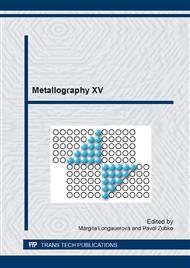p.491
p.495
p.499
p.503
p.507
p.513
p.519
p.523
p.527
The Effect of Ni Interlayers on Compaction of Mo/Mo Silicide Composites
Abstract:
Abstract: Reactions during compaction of Mo/Mo silicide wires with Ni interlayers are qualitatively assessed in this work. It appeared that due to extreme high temperature strength of MoSi2 hot pressing even at 1800°C/60 min/30 MPa in vacuum had not been sufficient to compact the Mo/Mo silicide wires in the absence of any additional interfacial layer. Therefore Ni had been chemically coated on the surface of Mo/Mo silicide wires that were subsequently compacted by hot pressing. Structural analysis revealed the reaction between Ni and MoSi2 resulting in the formation of ternary (MoNiSi) compounds. These established an interfacial bonding with minimal porosity.
Info:
Periodical:
Pages:
507-512
Citation:
Online since:
April 2014
Keywords:
Price:
Сopyright:
© 2014 Trans Tech Publications Ltd. All Rights Reserved
Share:
Citation:


